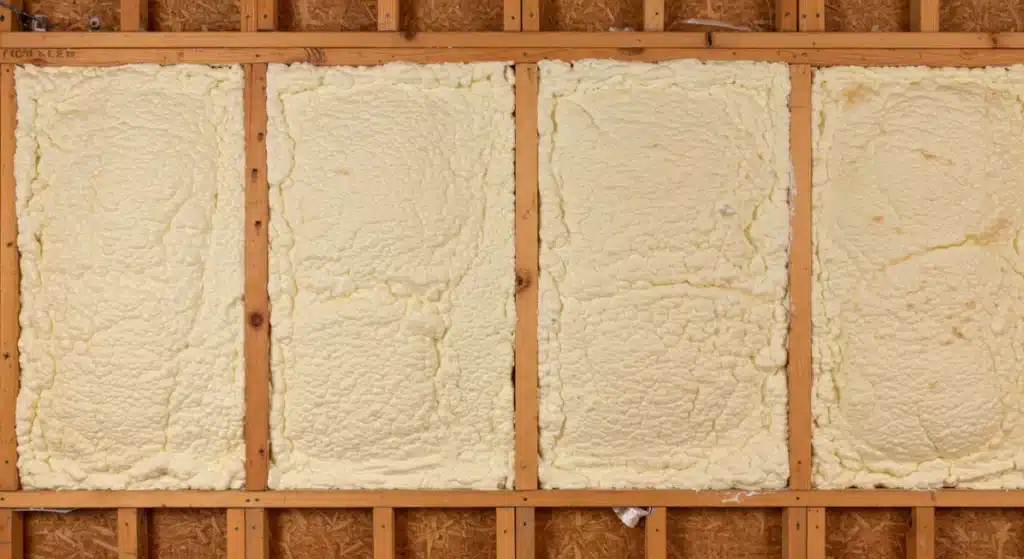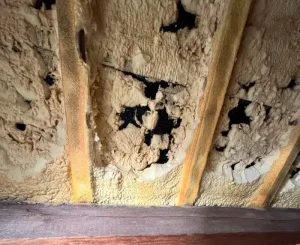Spray foam insulation thickness in Masterson, TX depends on climate demands, building usage, and compliance with energy efficiency standards. For most residential and commercial structures in the region, spray foam thickness typically ranges between 2 to 6 inches, with exact specifications determined by the insulation’s purpose (thermal barrier, air seal, or sound dampening).
Closed-cell foam generally requires less thickness than open-cell foam to achieve the same R-value. Local building codes, climate zone requirements (Zone 4 in Masterson), and HVAC load calculations also guide appropriate thickness levels. Incorrect thickness can lead to reduced energy savings and potential moisture issues.
Flatland Roofing & Insulation applies decades of field experience in commercial and residential insulation installation across West Texas. The following guide outlines the key variables that affect spray foam thickness, backed by technical data and regional expertise.
Factors That Influence Spray Foam Thickness
Building Purpose and Envelope Type
- Residential walls often require less thickness than commercial roofs.
- Metal structures may need thicker applications for condensation control.
Bonus Tip: Use infrared scans post-installation to confirm coverage and identify any gaps that may affect performance.
Open-Cell vs Closed-Cell Foam
| Characteristic | Open-Cell Foam | Closed-Cell Foam |
|---|---|---|
| R-Value per inch | ~3.5 | ~6.5 |
| Air Barrier | Yes | Yes |
| Vapor Barrier | No | Yes |
| Typical Wall Thickness | 3.5″ to 5.5″ | 2″ to 3″ |
| Cost per sq ft (avg TX)* | $0.45 – $0.65 | $1.00 – $1.50 |
Local Climate Zone (Zone 4)
Masterson falls in Climate Zone 4, which requires:
- R-13 to R-21 for walls
- R-38 or higher for attics and ceilings
- Additional vapor control in semi-arid conditions
Structural Material and Thermal Bridging
Metal frames and concrete block walls conduct more heat than wood, requiring adjusted insulation thickness to compensate. Roof decks with metal panels often need denser coverage.
Bonus Tip: Apply spray foam over structural thermal breaks to improve system-wide performance and reduce condensation risk.
Air and Moisture Control Objectives
If air sealing is the priority, thinner layers of closed-cell foam may suffice. For vapor control or thermal resistance, thicker applications or multi-layer passes may be required.
Technical Specification Table
| Application Area | Recommended Foam Type | Target R-Value | Typical Thickness (inches) | Notes |
|---|---|---|---|---|
| Interior Walls | Open-Cell | R-13 to R-21 | 3.5 – 5.5 | Acoustic benefit, not a vapor barrier |
| Roof Deck (Metal) | Closed-Cell | R-30+ | 4 – 6 | Vapor barrier, controls condensation |
| Attic Floor | Open or Closed-Cell | R-38 | 5 – 6.5 | Depends on HVAC location |
| Crawlspace | Closed-Cell | R-19 | 3 – 4 | Must manage ground moisture |
Regional Considerations for Masterson, TX
- Wind Exposure: Flat terrain can accelerate infiltration rates; air sealing is critical.
- Temperature Swings: 90+ degree days and sub-freezing nights call for higher R-values.
- Humidity Management: Semi-arid, but vapor control is still needed in conditioned spaces.
Market Insights
- Buildings with correctly installed spray foam insulation reduce energy costs by 20% to 40% (U.S. DOE, 2024).
- Closed-cell foam is increasingly preferred for metal building retrofits in West Texas due to structural reinforcement properties (NAIMA 2023 Survey).

Things to Consider Before Making a Decision
- Is the primary goal thermal insulation, air sealing, or both?
- What type of structure is being insulated (wood frame, metal, concrete)?
- Will the area be conditioned or unconditioned?
- Are there local code mandates for insulation thickness?
- What is the expected return on investment?
Bonus Tip: Always verify manufacturer specs for foam expansion rates and curing times before applying multiple passes.
Relevant Services from Flatland Roofing & Insulation
- Blown-In Insulation Installation: For attics where spray foam is not suitable or cost-effective.
- Dense-Pack Cellulose: Ideal for retrofitting closed walls without major demolition.
- Metal Roof Restoration: Combines insulation and waterproofing with spray foam and coatings.
- Commercial Insulation Solutions: Full-system design for energy code compliance and durability.
Common Questions About Spray Foam Thickness
- Can you spray too much foam? Yes. Excess foam can stress framing and reduce structural airflow. Always apply according to specs.
- Does thicker foam mean better performance? Up to a point. R-values improve with thickness, but diminishing returns apply beyond required levels.
- Is one pass enough for closed-cell foam? Not always. Depending on the desired R-value and cavity depth, multiple passes may be needed.
- What happens if foam is too thin? Underperformance in energy efficiency and increased condensation risk.
Get Expert Insulation Guidance
For precise insulation strategies based on your structure, climate, and performance goals, contact:
Flatland Roofing & Insulation Phone: (806) 606-6794 Email: info@flatlandroofcoatings.com
Frequently Asked Questions
How long does spray foam insulation last?
Properly installed spray foam can last 30 years or more without degradation, barring physical damage.
Can spray foam be applied in cold weather?
Yes, but surface prep and ambient temperature must meet product-specific thresholds (typically above 40°F).
Is spray foam safe for indoor air quality?
Once cured, closed-cell and open-cell foams are inert. Proper ventilation during installation is critical.
Will foam crack or shrink over time?
Closed-cell foam maintains structure well. Minor shrinkage may occur in open-cell foam if installed too thin.
Can existing insulation be combined with spray foam?
Yes, hybrid assemblies are common. Ensure no moisture-trapping materials are used between layers.





